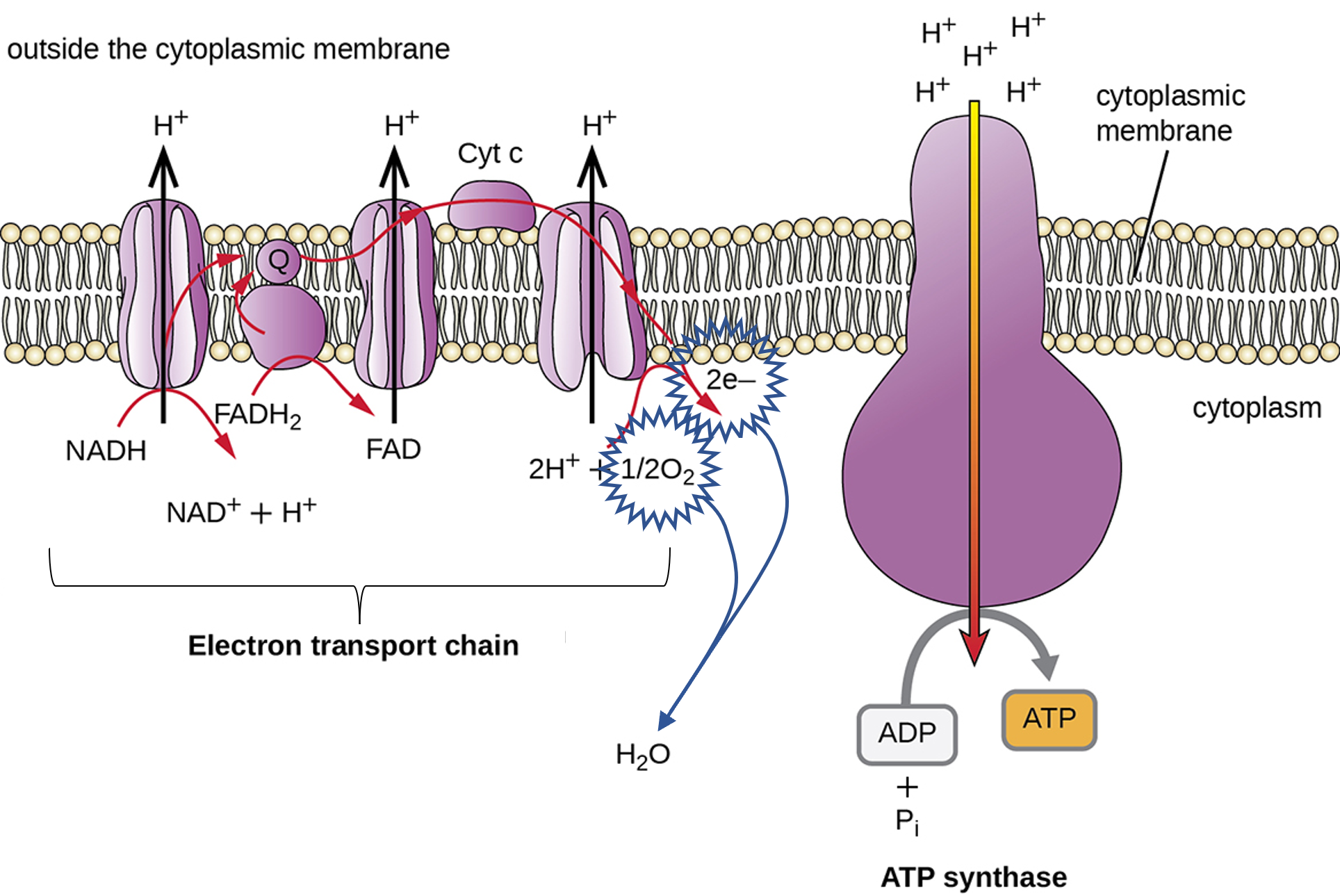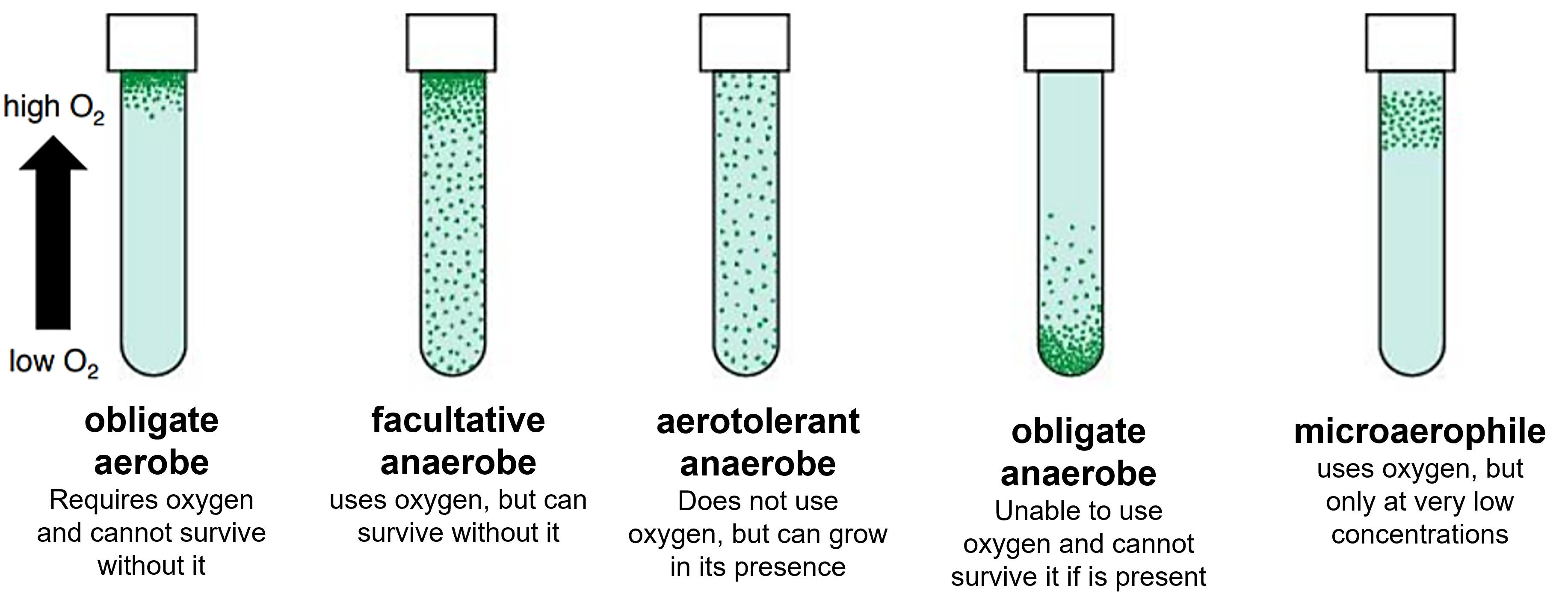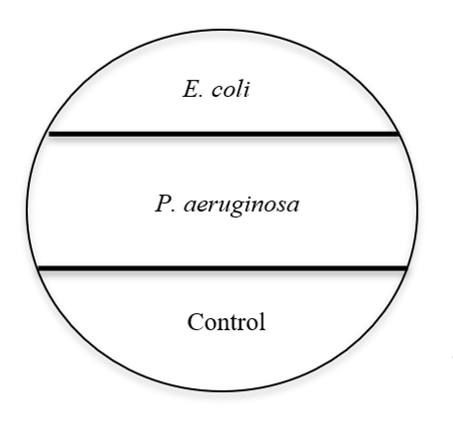5.5: Bacterial Oxygen Requirements
- Page ID
- 149784
\( \newcommand{\vecs}[1]{\overset { \scriptstyle \rightharpoonup} {\mathbf{#1}} } \)
\( \newcommand{\vecd}[1]{\overset{-\!-\!\rightharpoonup}{\vphantom{a}\smash {#1}}} \)
\( \newcommand{\dsum}{\displaystyle\sum\limits} \)
\( \newcommand{\dint}{\displaystyle\int\limits} \)
\( \newcommand{\dlim}{\displaystyle\lim\limits} \)
\( \newcommand{\id}{\mathrm{id}}\) \( \newcommand{\Span}{\mathrm{span}}\)
( \newcommand{\kernel}{\mathrm{null}\,}\) \( \newcommand{\range}{\mathrm{range}\,}\)
\( \newcommand{\RealPart}{\mathrm{Re}}\) \( \newcommand{\ImaginaryPart}{\mathrm{Im}}\)
\( \newcommand{\Argument}{\mathrm{Arg}}\) \( \newcommand{\norm}[1]{\| #1 \|}\)
\( \newcommand{\inner}[2]{\langle #1, #2 \rangle}\)
\( \newcommand{\Span}{\mathrm{span}}\)
\( \newcommand{\id}{\mathrm{id}}\)
\( \newcommand{\Span}{\mathrm{span}}\)
\( \newcommand{\kernel}{\mathrm{null}\,}\)
\( \newcommand{\range}{\mathrm{range}\,}\)
\( \newcommand{\RealPart}{\mathrm{Re}}\)
\( \newcommand{\ImaginaryPart}{\mathrm{Im}}\)
\( \newcommand{\Argument}{\mathrm{Arg}}\)
\( \newcommand{\norm}[1]{\| #1 \|}\)
\( \newcommand{\inner}[2]{\langle #1, #2 \rangle}\)
\( \newcommand{\Span}{\mathrm{span}}\) \( \newcommand{\AA}{\unicode[.8,0]{x212B}}\)
\( \newcommand{\vectorA}[1]{\vec{#1}} % arrow\)
\( \newcommand{\vectorAt}[1]{\vec{\text{#1}}} % arrow\)
\( \newcommand{\vectorB}[1]{\overset { \scriptstyle \rightharpoonup} {\mathbf{#1}} } \)
\( \newcommand{\vectorC}[1]{\textbf{#1}} \)
\( \newcommand{\vectorD}[1]{\overrightarrow{#1}} \)
\( \newcommand{\vectorDt}[1]{\overrightarrow{\text{#1}}} \)
\( \newcommand{\vectE}[1]{\overset{-\!-\!\rightharpoonup}{\vphantom{a}\smash{\mathbf {#1}}}} \)
\( \newcommand{\vecs}[1]{\overset { \scriptstyle \rightharpoonup} {\mathbf{#1}} } \)
\( \newcommand{\vecd}[1]{\overset{-\!-\!\rightharpoonup}{\vphantom{a}\smash {#1}}} \)
\(\newcommand{\avec}{\mathbf a}\) \(\newcommand{\bvec}{\mathbf b}\) \(\newcommand{\cvec}{\mathbf c}\) \(\newcommand{\dvec}{\mathbf d}\) \(\newcommand{\dtil}{\widetilde{\mathbf d}}\) \(\newcommand{\evec}{\mathbf e}\) \(\newcommand{\fvec}{\mathbf f}\) \(\newcommand{\nvec}{\mathbf n}\) \(\newcommand{\pvec}{\mathbf p}\) \(\newcommand{\qvec}{\mathbf q}\) \(\newcommand{\svec}{\mathbf s}\) \(\newcommand{\tvec}{\mathbf t}\) \(\newcommand{\uvec}{\mathbf u}\) \(\newcommand{\vvec}{\mathbf v}\) \(\newcommand{\wvec}{\mathbf w}\) \(\newcommand{\xvec}{\mathbf x}\) \(\newcommand{\yvec}{\mathbf y}\) \(\newcommand{\zvec}{\mathbf z}\) \(\newcommand{\rvec}{\mathbf r}\) \(\newcommand{\mvec}{\mathbf m}\) \(\newcommand{\zerovec}{\mathbf 0}\) \(\newcommand{\onevec}{\mathbf 1}\) \(\newcommand{\real}{\mathbb R}\) \(\newcommand{\twovec}[2]{\left[\begin{array}{r}#1 \\ #2 \end{array}\right]}\) \(\newcommand{\ctwovec}[2]{\left[\begin{array}{c}#1 \\ #2 \end{array}\right]}\) \(\newcommand{\threevec}[3]{\left[\begin{array}{r}#1 \\ #2 \\ #3 \end{array}\right]}\) \(\newcommand{\cthreevec}[3]{\left[\begin{array}{c}#1 \\ #2 \\ #3 \end{array}\right]}\) \(\newcommand{\fourvec}[4]{\left[\begin{array}{r}#1 \\ #2 \\ #3 \\ #4 \end{array}\right]}\) \(\newcommand{\cfourvec}[4]{\left[\begin{array}{c}#1 \\ #2 \\ #3 \\ #4 \end{array}\right]}\) \(\newcommand{\fivevec}[5]{\left[\begin{array}{r}#1 \\ #2 \\ #3 \\ #4 \\ #5 \\ \end{array}\right]}\) \(\newcommand{\cfivevec}[5]{\left[\begin{array}{c}#1 \\ #2 \\ #3 \\ #4 \\ #5 \\ \end{array}\right]}\) \(\newcommand{\mattwo}[4]{\left[\begin{array}{rr}#1 \amp #2 \\ #3 \amp #4 \\ \end{array}\right]}\) \(\newcommand{\laspan}[1]{\text{Span}\{#1\}}\) \(\newcommand{\bcal}{\cal B}\) \(\newcommand{\ccal}{\cal C}\) \(\newcommand{\scal}{\cal S}\) \(\newcommand{\wcal}{\cal W}\) \(\newcommand{\ecal}{\cal E}\) \(\newcommand{\coords}[2]{\left\{#1\right\}_{#2}}\) \(\newcommand{\gray}[1]{\color{gray}{#1}}\) \(\newcommand{\lgray}[1]{\color{lightgray}{#1}}\) \(\newcommand{\rank}{\operatorname{rank}}\) \(\newcommand{\row}{\text{Row}}\) \(\newcommand{\col}{\text{Col}}\) \(\renewcommand{\row}{\text{Row}}\) \(\newcommand{\nul}{\text{Nul}}\) \(\newcommand{\var}{\text{Var}}\) \(\newcommand{\corr}{\text{corr}}\) \(\newcommand{\len}[1]{\left|#1\right|}\) \(\newcommand{\bbar}{\overline{\bvec}}\) \(\newcommand{\bhat}{\widehat{\bvec}}\) \(\newcommand{\bperp}{\bvec^\perp}\) \(\newcommand{\xhat}{\widehat{\xvec}}\) \(\newcommand{\vhat}{\widehat{\vvec}}\) \(\newcommand{\uhat}{\widehat{\uvec}}\) \(\newcommand{\what}{\widehat{\wvec}}\) \(\newcommand{\Sighat}{\widehat{\Sigma}}\) \(\newcommand{\lt}{<}\) \(\newcommand{\gt}{>}\) \(\newcommand{\amp}{&}\) \(\definecolor{fillinmathshade}{gray}{0.9}\)- Explain how aerobic and anaerobic respiration differ.
- Define and recognize descriptions of obligate aerobes, obligate anaerobes, facultative anaerobes, microaerophiles, and aerotolerant anaerobes.
- Tell that bacterial species' oxygen requirements are useful for species identification and characterization.
- Describe how thioglycollate agar tubes work and how they can be used to determine bacterial species' oxygen requirements.
- Tell how anaerobic chambers and GasPak systems work to culture obligate anaerobe species.
- Successfully conduct and interpret thyioglycollate cultures to determine oxygen requirements of bacteria.
- Successfully grow bacteria in aerobic and anaerobic conditions and interpet the results.
O2 and Bacterial Metabolism & Growth
Bacteria can differ dramatically in their ability to utilize oxygen (O2). Under aerobic conditions, if the bacterial species can conduct aerobic respiration, oxygen acts as the final electron acceptor for the electron transport chain located in the plasma membrane of prokaryotes. Bacteria use the electron transport chain to generate a H+ gradient that is used by ATP synthase to make ATP. ATP is the energy source for most cellular processes and therefore essentially for keeping cells alive. In the absence of oxygen (O2), some bacteria can use alternative metabolic pathways including anaerobic respiration and/or fermentation. During anaerobic respiration, other alternative molecules are used as the final electron acceptor for the electron transport chain such as nitrate (NO3), sulfate (SO4), and carbonate (CO3).

The presence or absence of molecular oxygen can be a critical factor in the ability of bacteria to grow in each environment. When bacteria use oxygen in cellular respiration and other chemical reactions, toxic superoxide and peroxides are produced. These highly reactive byproducts damage the cell unless they are quickly neutralized. Aerobic bacteria (grow in O2 environments) produce enzymes such as catalase, peroxidase and/or superoxide dismutase that break down toxic forms of oxygen and their intermediate byproducts. Bacteria called anaerobes produce ATP via anaerobic means (anaerobic respiration and/or fermentation). Anaerobes have no tolerance for oxygen since they cannot produce catalase, peroxidase and/or superoxide dismutase to remove toxic byproducts of O2.
Bacterial species are classified by their oxygen requirements as follows:
- obligate aerobes: Produce ATP via aerobic respiration. Require around 20% atmospheric oxygen.
- microaerophiles: Produce ATP via aerobic respiration or fermentation. Require between 5-15% atmospheric oxygen for growth.
- aerotolerant anaerobes: Produce ATP via anaerobic respiration and can conduct fermentation. Oxygen can be present, but they do not utilize it for ATP production or fermentation.
- facultative anaerobes: Produce ATP via aerobic respiration, anaerobic respiration, and/or fermentation. These organisms grow equally well in aerobic or anaerobic environments.
- obligate anaerobes: Produce ATP via anaerobic respiration or fermentation. These bacteria die in the presence of O2 because they lack the enzymes needed to break down toxic forms of oxygen and their intermediate byproducts.
Since bacterial species differ in their oxygen requirements, testing this feature is useful for identifying and characterizing bacterial species.
Determining Bacterial Oxygen Requirements with Thioglycollate Medium
Thioglycollate is a medium designed to test the aerotolerance (tolerance to O2) of bacteria. Along with nutrients, it contains a reducing agent, sodium thioglycollate, which combines with oxygen to produce water. Thioglycollate also contains a small amount of agar which helps reduce oxygen diffusion and helps maintain the stratification of organisms growing in different layers of the broth. Because the thioglycollate can eliminate the oxygen in the bottom of the tube, but not at the surface, varying concentrations of oxygen are found within the tube. On occasion, an indicator is added to the media to indicate the presence or absence of oxygen and shows where the aerobic and anaerobic zones separate. For example, resazurin is pink in the presence of oxygen and colorless when reduced.
One can determine a bacterium's oxygen requirements by cultivating them in a special medium called thioglycollate agar tubes. Based on the location and distribution of the bacteria in these tubes, a species can be classified as obligate aerobe, microaerophile, facultative anaerobe, aerotolerant anaerobe, or obligate anaerobe.

Growing Bacteria in Strict Anaerobic Conditions
Anaerobic Chambers
The cultivation of anaerobic bacterial species requires an anaerobic chamber. This is a special chamber is a closed environment without O2 where the microbiologist can work with and cultivate obligate anaerobes without exposing them to oxygen. Anaerobic chambers contain a hydrogen (H2) gas mixture that is circulated through a heated palladium catalyst to remove oxygen (O2) by forming water (H2O). Anaerobic chambers use a gas mixture of H2 and nitrogen gas (N2) (5/95%) or N2/carbon dioxide (CO2)/H2 (85/10/5 %) to remove oxygen. An airlock is used to reduce O2 levels prior to the transfer of samples in and out of the chamber.
.jpg?revision=1&size=bestfit&width=660&height=556)
GasPak Anaerobic Systems
A Gas Pak jar or bag is an alternative way to grow strict anaerobes that must be grown in an atmosphere without oxygen. Plates or tubes are placed in a sealed jar or bag along with a GasPak envelopes that functions as a hydrogen and carbon dioxide generator. The hydrogen combines with the oxygen in the jar to produce water. A palladium catalyst in the chamber or bag catalyzes the formation of water from hydrogen and oxygen, thereby removing the O2. To insure anaerobic conditions are effectively produced in the GasPak jar or bag, a strip of paper soaked in methylene blue dye is included in the jar or bag. Methylene blue is colorless in an anaerobic environment and blue in an aerobic environment. These systems are compact, easy to use, and less expensive than an anaerobic chamber.

Laboratory Instructions
Growing Bacteria With & Without O2

- On the underside of two TSA Petri plates, use a marker to create 3 sections on the Petri plate (see image above) with the sections labeled as Escherichia coli, Pseudomonas aeruginosa, and Control. Depending on the circumstances, your instructor may also choose to include another section with a Clostridium species as well. If that is the case, create an additional section and label it with the Clostridium species name. Label one plate as "aerobic" and the other plate as "anaerobic."
- Aseptically inoculate each section of the petri plates with the corresponding bacterial species. You may use a streak in a straight line or a zig-zag pattern within the labeled section for each. Leave the Control section without any added bacteria.
- Incubate the aerobic plate as usual at 37 °C. The anaerobic plate will be placed in an anaerobic jar or anaerobic bag and a GasPak pouch. THe GasPak will be activated by your instructor to generate an anaerobic environment and then incubated at 37 °C.
Results & Discussion
Growing Bacteria With & Without O2
- Examine the aerobic and anaerobic petri plates and record the results.
- Explain how these results relate to aerobic respiration and anaerobic respiration?
- True or False. All bacterial species can grow in the presence of oxygen. Explain your answer.
- True or False. All bacterial species can grow in the absence of oxygen. Explain your answer.
- How does the GasPak system produce an anaerobic environment?
- Can testing the oxygen tolerances of bacterial species be useful for species identification and characterization? Explain your answer.
Attributions
- Anaerobic chamber (6790409341).jpg by Oak Ridge National Laboratory is licensed under CC BY 2.0
- Chapter Image: Microbiology Labs I by Delmar Larsen and Jackie Reynolds
- MB352 General Microbiology Laboratory 2021 (Lee) by Alice_Lee@ncsu.edu is licensed under CC BY-NC-SA 4.0
- Microbiology by OpenStax is licensed under CC BY 4.0
- Red Mountain Microbiology by Jill Raymond Ph.D.; Graham Boorse, Ph.D.; Anne Mason M.S. is licensed under CC BY-NC 4.0


